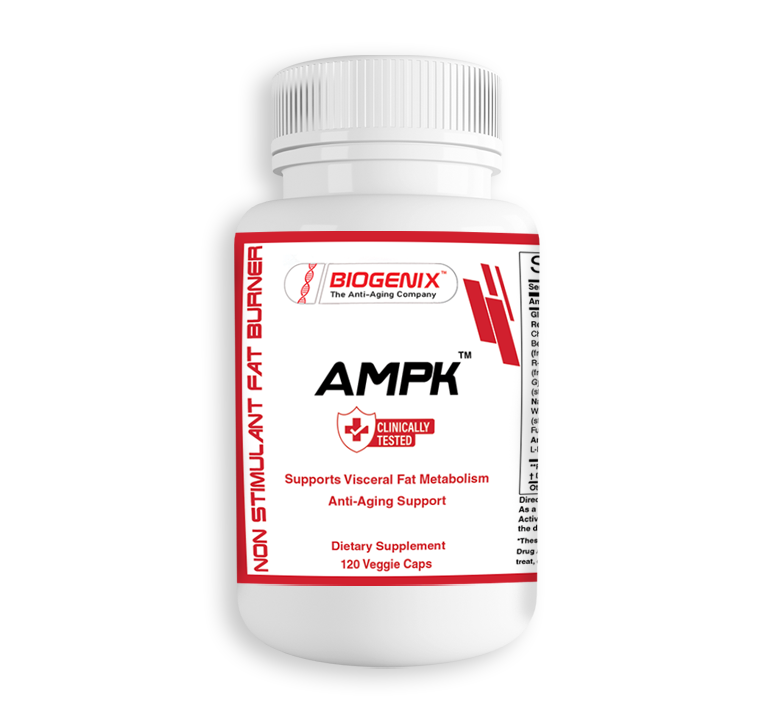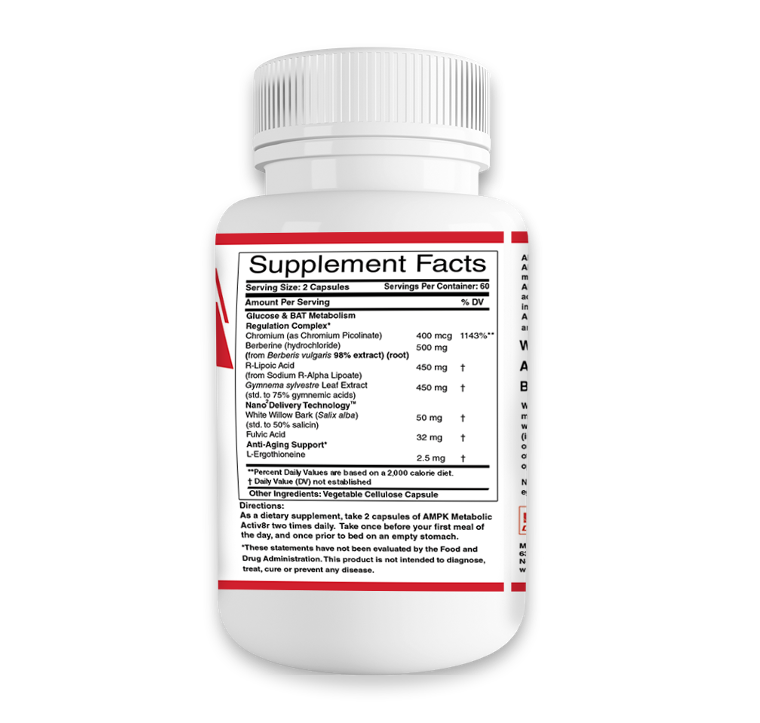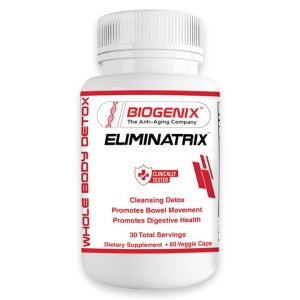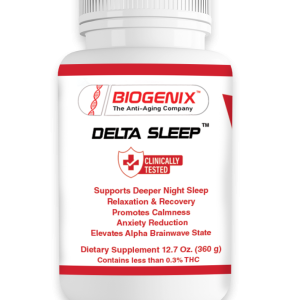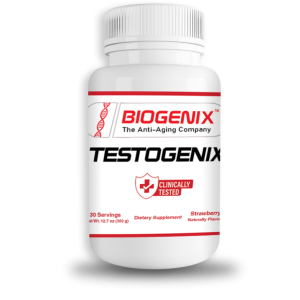What is AMPK?
Adenosine monophosphate-activated protein kinase (AMPK) is a key fuel sensor of cellular energy status, regulating cellular and whole-body homeostasis. AMPK is activated by ratios of adenosine monophosphate (AMP)/adenosine triphosphate (ATP) and or adenosine diphosphate (ADP)/ATP.
When cellular energy, ATP, levels fall, AMPK induces catabolic pathways that generate ATP – the energy needed by cells to function, while inhibiting anabolic pathways and other pathways that consume ATP. This energy switch can influence multiple pathways including lipid and glucose metabolism, protein metabolism, autophagy, and mitochondrial biogenesis.
Mechanism of AMPK
AMPK can be found in several tissues in the body, including the liver, brain, and skeletal muscle. AMPK is known as the fuel of the cell, working to ensure ATP levels are maintained under energetic stress situations such as exercise.
The binding of AMP and ADP result in activation of AMPK. Once activated, AMPK phosphorylates key targets to rewire the metabolism. Dependent on which gene is triggered many metabolic processes may result.
Aging can reduce AMPK sensitivity to cellular stress, impairing downstream signaling and maintenance of cellular energy balance. Alterations in AMPK signaling decrease mitochondrial biogenesis, increase cellular stress and induce inflammation. Therefore, AMPK has been identified as a key target for slowing the aging process, increasing fat oxidation pathways, and glucose metabolism and stimulating insulin secretion and sensitivity.
BioGenix has created a unique AMPK formulation, AMPK Metabolic Activ8rTM helps switch on pathways to increase insulin secretion and sensitivity, increase fat oxidation via BAT activation, reduce post-workout muscle inflammation and provide antioxidants for protection against the aging process. This review will breakdown the formulation ingredients including the mechanism and clinical research supporting their effectiveness.
Ingredients
Glucose & BAT Metabolism Regulation Complex
Chromium
An essential mineral needed in the diet, chromium has been shown to reduce food intake, body weight and increase glucose metabolism. The mechanism for chromium’s action is by improving the function of the glucose transporter GLUT-4, increasing translocation and up-take of glucose into fat cells via lowering plasma membrane cholesterol and mediating AMPK activation. Chromium also has action on the adiponectin hormone, which is released by fat tissue to help increase insulin sensitivity.
Berberine
Berberine is a plant alkaloid extracted from Berberis vulgaris and has traditional uses in Chinese and Ayurvedic medicine for approximately the last 2500 years. It has shown to be effective for improving blood glucose disposal, improving insulin efficiency, lipid metabolism and body composition.
Berberine has been shown to regulate glucose and lipid metabolism, working on both fat cells and muscle cells inducing a variety of metabolic effects consistent with AMPK activation.
Berberine enhances insulin secretion, stimulates glycolysis (breakdown of sugar), suppresses adipogenesis (production of fat cells), activating AMPK pathway and increasing glycokinase (glucose regulation) activity.
Berberine, reduces intestinal glucose absorption, and up-regulates the expression of GLUT-4 translocation, stimulating glucose up-take, and upregulating glucagon like peptide (GLP-1) genes.
R-Alpha Lipoic Acid
Alpha Lipoic Acid is a potent antioxidant, that acts as a cofactor involved in energy generation in the mitochondria of the cell. ALA has also been shown to reverse oxidative damage related to the effects of aging, assist in weight loss, appetite control and fat metabolism.
The metabolic action of ALA is mediated by activation of AMPK. ALA can regulate insulin secretion and sensitivity, mimic caloric surplus causing appetite suppression and regulating lipid metabolism.
ALA down-regulates key lipogenic enzymes, inhibiting lipogenesis and reducing triglyceride accumulation through the activation of AMPK signaling pathway in fat cells. ALA upregulates adiponectin expression in WAT (white adipose tissue), a key hormone involved in insulin sensitivity.
Gymnema sylvestre
Gymnema sylvestre is a plant used in traditional Ayurvedic medicine, for its therapeutic benefits when it comes to controlling blood sugar. Gymnema sylvestre has shown positive effects on blood sugar homeostasis, controlling sugar cravings, and promoting regeneration of the pancreas.
Gymnema sylvestre’s mode of action is through the stimulation in insulin secretion from the pancreas and by delaying glucose absorption in the blood. The main active component of Gymnema, gymnemic acids, has a chemical structure that fills the receptors in the taste buds but also in the intestines, preventing absorption of sugar. Gymnemic acids can also trigger insulin secretion and regeneration of islet cells of the pancreas enhancing up-take of glucose.
This process decreases glucose and fatty acid assimilation in the small intestine and interferes in the ability of receptors in mouth and intestine to the sensation of sweetness. Gymnemic acids may downregulate AMPK-mediated gluconeogenesis.
L-Ergothionenine
L-ergothioneine (ET) is a thiol form of the natural amino acid histidine that can be considered an anti-aging, super antioxidant compound. Thiol-based antioxidants are considered the most powerful antioxidants in nature.
In the body, ET is concentrated in cells and tissues frequently exposed to oxidative stress. It has also been shown that there are specific transporters for ET in the body, with abundant levels in tissues. ET transporters (ETT) move ET throughout the body, via the blood, storing it in locations that are high in free radical activity.
Cells lacking ETT are more susceptible to oxidative stress, resulting in increased mitochondrial DNA damage, protein oxidation, cytokine inflammatory response and lipid peroxidation. ET therefore acts as a strong antioxidant and anti-inflammatory compound. Additionally, it prevents lipid peroxidation and protects both mitochondria and DNA.
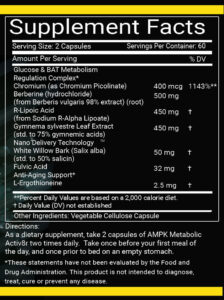
Warnings: Do not use if the safety seal is broken or missing. It is not recommended for pregnant/nursing women. Consult a physician if taking medication (including insulin and oral diabetic medications) or have a medical condition. Keep out of reach children. Store in a cool, dry place after opening. Never exceed the recommended dose.
Description
AMPK is formulated to stimulate AMPK activity. AMPK – activated protein kinase is a metabolic regulator of energy metabolism. Increasing AMPK activity increases BAT (Brown Adipose Tissue) activation, increasing energy expenditure or thermogenesis in the body, resulting in an increase in fat metabolism*. AMPK activity has also been linked to anti-aging benefits and increases in longevity*.
- Anti-Aging Support
- Weight Management
- Appetite Support
- Blood Glucose Control
- Supports Visceral Fat Metabolism

